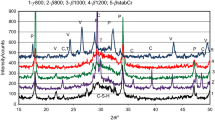Abstract
The process of shrinkage of calcium silicate hydrate was investigated by dilatometry up to 350 °C. The properties of this material are based on the formation of C–S–H phases during the reaction at temperatures between 180 and 205 °C and water vapor pressure lower than 16 bars. The main C–S–H phases are 11.3 Å tobermorite and xonotlite. 11.3 Å tobermorite converts to 9.3 Å tobermorite on air at temperatures around 300 °C. The hydrosilicate materials were prepared from quicklime and finely ground sand with different CaO/SiO2 ratios under different hydrothermal conditions. The reaction time was 24 h. Materials based on xonotlite and tobermorite were produced, and the calcium silicate phases were characterized by XRD and TG/DTA methods. Dilatometry measurements were used to study the effect of heating conditions on sample shrinkage. Dehydration of hydrated calcium silicate minerals occurred during heating. The results show that sample shrinkage is dependent on the type and amount of C–S–H phases, the amount of bound water and formation of 9.3 Å tobermorite. All samples showed shrinkage after heating up to 350 °C, but this change was not irreversible for all samples after cooling to room temperature.






Similar content being viewed by others
References
Shaw S, Henderson CMB, Komanschek BU. Dehydration/recrystallization mechanism, energetics, and kinetics of hydrated calcium silicate minerals: an in situ TGA/DSC and synchrotron radiation SAXS/WAXS study. Chem Geol. 2000;167:141–59.
Hara N, Inoue N. Thermal behaviour of 11 Å tobermorite and its lattice parameters. Cem Concr Res. 1980;10:53–60.
Merlino S, Bonaccorsi E, Armbruster T. Tobermorites: their real structure and order-disorder (OD) character. Am Mineral. 1999;84:1613–21.
Speakman K. The stability of tobermorite in the system CaO–SiO2–H2O at elevated temperatures and pressures. Mineral Mag. 1968;36:1090–103.
Hartmann A, Schulenberg D, Buhl JC. Synthesis and structural characterization of CSH-phases in the range of/S = 0.41–1.66 at temperatures of the tobermorite xonotlite crossover. J Mater Sci Chem Eng. 2015;3:39–55.
Shaw S, Clark SM, Henderson CMB. Hydrothermal formation of the calcium silicate hydrates tobermorite (Ca5Si6O16(OH)2·4H2O) and xonotlite (Ca6Si6O17(OH)2): an in situ synchrotron study. Chem Geol. 2000;167:129–40.
Bernstein S. Determination of reaction kinetics and mechanism of 1.13 tobermorite in situ neutron diffraction. Prog Cryst Growth Charact Mater. 2012;58:84–9.
Kikuma J, et al. Effect of quartz particle size and water-to-solid ratio on hydrothermal synthesis of tobermorite studied by in situ time-resolved X-ray diffraction. J Solid State Chem. 2011;184:2066–74.
Nocuń-Wczelik W. Effect of Na and Al on the phase composition and morphology of autoclaved calcium silicate hydrates. Cement Concrete Res. 1999;29:1759–67.
Chatterji S. The role of interlayer spacing and water in the drying shrinkage of tobermorite based materials. Cem Conc Res. 1975;5:83–7.
Kalousek GL, Mitsuda T, Taylor HFW. Xonotlite: cell parameters, thermogravimetry and analytical electron microscopy. Cem Concr Res. 1977;7:305–12.
Spudulis E, Šavareika V, Špokauskas A. Influence of hydrothermal synthesis condition on xonotlite crystal morphology. Mater Sci. 2013;19:190–6.
Hong SY, Glasser EP. Phase relations in the CaO–SiO2–H2O system to 200 °C at saturated steam pressure. Cem Concr Res. 2004;34:1529–34.
Mitsuda T, Taylor HFW. Normal and anomalous tobermorite. Mineral Mag. 1978;42:229–35.
Guo X, Meng F, Shi H. Microstructure and characterization of hydrothermal synthesis of Al-substituted tobermorite. Constr Build Mater. 2017;133:253–60.
Kuzielova E, Zemlicka M, Masilko J, Palou MT. Pore structure development of blended G-oil well cement submitted to hydrothermal curing conditions. Geothermics. 2017;68:86–93.
Yu P, Kirkpatrick RJ. Thermal dehydration of tobermorite and jennite. Concr Sci Eng. 1999;1:185–91.
Palou MT, Kuzielova E, Novotny R, Soukal F, Zemlicka M. Blended cements consisting of Portland cement–slag–silica fume–metakaolin system. J Therm Anal Calorim. 2016;125:1025–34.
MacKenzie RC. Differential thermal analysis: fundamental aspects. 1st ed. London: Academic Press; 1970.
El-Hemaly SAS, Mitsuda T, Taylor HFW. Synthesis of normal and anomalous tobermorites. Cem Concr Res. 1977;7:429–38.
Acknowledgements
This paper was elaborated with the institutional support for long-term development of research organizations by the Ministry of Industry and Trade of the Czech Republic.
Author information
Authors and Affiliations
Corresponding author
Rights and permissions
About this article
Cite this article
Kubátová, D., Zezulová, A., Rybová, A. et al. Application of dilatometric analysis to the study of autoclaved calcium silicate materials. J Therm Anal Calorim 133, 399–404 (2018). https://doi.org/10.1007/s10973-017-6882-3
Received:
Accepted:
Published:
Issue Date:
DOI: https://doi.org/10.1007/s10973-017-6882-3




